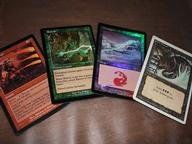Quiz Answer Key and Fun Facts
1. Mirrodin was the first non-core set in the new card frame, so at its time, there was no Modern format just yet. However one artifact card in the block made an immediate impact in the Vintage format because of its ability to stop the Moxen and Black Lotus. What was this card?
2. Kamigawa made legendary permanents, particularly creatures, the focus of the block. Of the 163 legendary cards, one was printed with two different pictures for a good reason - which one?
3. The most famous and sought after cards of the Ravnica block are its dual lands, the first since the original Alpha dual lands to actually have the two basic land types matching their colors. Due to their drawback compared to the ones from twelve years earlier, which name have players given to this cycle of lands?
4. Out of the three sets in the Time Spiral block, the third, Future Sight, made the biggest splash with the futureshifted cards - cards that hinted at possible future releases. One green creature did not only become one the most desirable Modern format creatures but also was the first hint towards a new, very flavorful, card type. Which one?
5. Lorwyn, the first set following Future Sight, immediately made good on Future Sight's promise by introducing the Planeswalker card type. Of these planeswalkers, considered the iconic ones for their colors, which was NOT a member of the Lorwyn Five?
6. The Lorwyn year, 2007/2008, saw four sets of the usual three, arranged into two half-blocks. Shadowmoor, the second half, was a dark alternate of Lorwyn. Several mechanics were put into Shadowmoor as direct contrasts to their Lorwyn counterparts. Which of these was NOT one of them?
7. The events of Alara block take place on a plane split into five shards that each supported only three of the five colors of mana. Out of these, one introduced (apart from a preview in Future Sight) the concept of colored Artifacts. Which shard was this artificer-themed one?
8. Zendikar block's second set, Worldwake, saw the first planeswalker to have more than three abilities - and also the first, and as of 2016, still only planeswalker card to have received the dubious honor of getting banned in Modern. Which (in)famous card is this?
9. Scars of Mirrodin was the first block to revisit a plane previously explored in the Modern format. Like the first Mirrodin set, this block also contained a Mox, a zero-cost artifact capable of tapping for mana. Which of these moxen, balanced by its Metalcraft restriction, is from Scars of Mirrodin?
10. Innistrad block introduced a controversial but mostly popular novelty in the form of double-faced cards. Out of the 33 double-faced cards in the block, only one was a planeswalker. On the back face, his/her subtitle is "the Veil-Cursed"; what is the name on the front face of the card?
11. Following in the footsteps of the incredibly popular Ravnica block, the second visit to the plane used an unusual and previously unseen arrangement of sets within the block. What configuration was chosen for this block?
12. Based on Greek mythology, Theros block chronicles the rise and downfall of a planeswalker to the seat as fifteenth god of the plane. Which one of the two-colored lesser gods began the story of Theros as a planeswalker and ended up slain in the end?
13. Tarkir block shows two alternate versions of the plane of Tarkir: one in which dragons had died out and the five Khans were the leaders of warring clans, and the other in which the plane was still ruled by the ancient dragonlords. Which of these is not one of the dragonlords but rather a juvenile tyrant who ultimately wound up as the centerpiece of a dragonlord's necklace?
14. Battle for Zendikar, the second visit to the plane that long held the Eldrazi titans captive, featured an ultra-rare subset of 45 land reprints with alternate art and a special, extra-shiny foil treatment. Under which name was this subset (which carried its own expansion symbol) marketed?
15. Our journey through fourteen years of Modern comes to an end with the second visit to Innistrad, called Shadows of Innistrad. The pivotal event of the story is the madness and ensuing unmaking of the protector archangel of the plane. What was the name of this archangel whose unfortunate transformation was depicted in a double-faced card with a white front and a red back?
Source: Author
WesleyCrusher
This quiz was reviewed by FunTrivia editor
ozzz2002 before going online.
Any errors found in FunTrivia content are routinely corrected through our feedback system.

